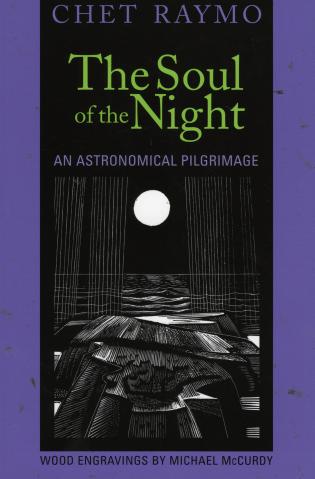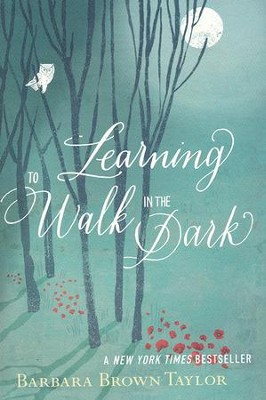
Chet Raymo, The Soul of the Night: An Astronomical Pilgrimage
(1985, Cambridge, MA: Cowley, 1992), 209 pages, each chapter illustrated with a woodblock print.
This may go down as the best book I’ve read all year. Raymo describes himself as a “pilgrim of darkness.” The journey and the night sky seem to provide him with joy. I am not sure why it has taken me so long to discover this fellow pilgrim. A blogger friend suggested that I might like another of his books. When I looked him up, I saw this book and decided to read it first. After all, one of my favorite times to walk is at night. With a clear sky, it feels as if the stars accompany me on my travels.
The Soul of the Night is a collection of twenty essays. In each, the author begins with an observation that leads him deeper into the subject. It may be something on earth (especially birds) that lead him skyward. Or it could be an astronomical sighting that leads him back to earth. In these essays, he draws on his experience as a professor of physics and astronomy. Weaving his scientific knowledge with a keen sense of observation, the author draws on his vast background of information. There’s mythology, the Bible, the natural world, world religions (especially Zen), and literature (especially poetry).
In these pages, we ponder the beauty of the stars and the night from our perspective as well as the perspective of our ancient ancestors. We learn of how legends became constellations and how what we see as a vast flat canvas is a universe that’s spreading apart at an astonishing rate. He tells of illustrating our galaxy by spreading a box of salt in a swirl on the floor. But before his students take too much comfort in how close the “stars” are, he reminds them that to be precise, it would require a dozen boxes of salt and the positioning of each grain of salt would have to be thousands of feet from each other and would require a plane larger than a cross section of the earth (101-2). A grain of salt every 1000 feet. It’s enough to bog the mind. He investigates the meaning of darkness. He explores the color of the stars (which we can barely make out with the necked eyes) as well as the color of the landscape. Quoting a friend, he notes that “walking in the woods in November is like walking in a black and white landscape.” He ponders the shadows of the earth and the moon and how they helped understand the distances between objects. There is so much within these pages.
This is a delightful book that has given me much to ponder. I highly recommend it.

Barbara Brown Taylor, Learning to Walk in the Dark
(New York: HarperCollins, 2014), 200 pages
The title of this book intrigued me. I have long been a fan of Barbara Brown Taylor and have read most everything she’s published. An Altar in the World and When God is Silent are favorites. I have recommended and lent these two volumes to many people. In the 90s, I was blessed to spend a week with her and a small group at San Francisco Theological Seminary. I came to admire not only her careful use of language but also her love of the natural world. When I saw she’d written a book about darkness, I ordered it and immediately started reading, sitting aside other books that I was already reading.
Taylor describes her book as a journal instead of a “how-to” manual. She begins with a phrase most of us who grew up in an age when kids played outside all day have heard: our mom’s calling us, saying, “Come inside now, it’s getting dark.” From an early age, we are taught to fear the dark. Darkness also becomes a metaphor for all that is bad, which is seen through the Jewish and Christian scriptures. Yet, as Taylor points out, the God of the Scriptures is responsible for the darkness, too, having separated day from night. And besides, there are many good things that happen at night in Scripture (44f). She also raises questions about our “full solar spirituality” which only focuses on the light, the pleasant, the sunny. Such spirituality sees everything as positive and upbeat, but such theologies fail to provide support when things fall apart. Quoting theologians and others who have written on darkness and what we might learn from such experiences, she sets off on her journey. Along the way, she ponders the idea of restaurants where one eats in the dark. As you are served, you are told where your food is at on your plate (93ff). She goes through a “blind exhibit” where she gets to experience what’s it like to move through the world without sight (96ff). She crawls through a cave in West Virginia. And she spends the night alone in a cabin in the woods, experiencing night in a new way (153ff).
By exploring darkness, Taylor has an opportunity to explore an overlooked branch of theology that expresses what God isn’t, instead of what God is. There is an ancient root to this. Augustine, in the 4th Century, said, “If you have understood, what you have understood is not God” (144). She spends time with the writings of John of the Cross who believed “positive statements about God serve chiefly to fool people into believing that their half-baked images of God and their flawed ideas about how God acts are the Real Thing.” By teaching what God is not, John attempts “to convince his readers that their images and ideas about ‘God’ are in fact obstacles between them and the Real Thing” (38).
The lunar cycle provides the structure for the book. She recalls the parallel between the three days separating the old (waning) moon and the new (waxing) moon to the death and resurrection of Jesus (108). At the end of Taylor’s journey, she experiences a moonrise, a new experience for her (166ff). I was shocked at this, perhaps because I grew up close to the ocean and have experienced many moonrises, especially in the fall of the year while surf fishing at night. Before the moon appears, there is a light on the distant horizon, and when it rises, it appears to be much larger than it does when overhead, and its rays seem to shimmer across the water as if they were directed at you. Taylor’s moonrise was moving enough that she decided to make a point to experience more such events. I also found myself wishing that she had experienced a night sleeping under the stars in the desert or high in the mountains, where you wake and gauge the time by how far the stars appear to have moved across the heavenly sphere.
Although the book may fail to teach us to walk in the dark, it does help us appreciate what we gain from the absence of light. Quoting Carl Jung, we’re reminded that “one does not become more enlightened by imaging figures of light, but by making the darkness conscious.” (86) There is much we might learn from the darkness and Taylor’s book is a beginning guide to help us see when the lights dim, and the shadows overtake us.
I read and wrote this review in 2014.

Both books sound really good.
Both of these sound excellent. I’m familiar to Chet Raymo’s other book, The Path. Loved his voice. Taylor’s book is also appealing. I have a character in my latest trilogy that is going blind, must traverse his world as though in the dark. Taylor’s book might allow more depth as I explore this situation.
Jacqui, you are the one who suggested “The Path” to me, which led me to this book. I will get back to “The Path.” I enjoyed his writing style.
The Soul of the Night sounds like the perfect book for me.
As for darkness itself, I’m a little ashamed to write this but up until my late-40s I had to have a small light on at night. Yes, a nightlight and the main reason was me waking up in total darkness several times as a kid. It seriously freaked me out.
But after working a bunch of years on nightshift I came to relish the darkness. During my weekends off when I slept like a normal person the darkness meant comfort and a good sleep.
Didn’t the army have you out at night? When I worked night shift in the bakery, as a supervisor, I’d time my breaks to go out onto the loading dock and watch the sky change as the sun approached.
You’ve sparked my interest in these two books. I’m especially drawn to The Soul of the Night. Thanks, Jeff.
These both sound quite interesting. There are three Barbara Brown Taylor books available through my library app and I have them all tagged to read someday. Unfortunately, this isn’t one of them.
The best book you ever read? Must be out-of-this world.
Blessings, Jeff.
No, I said its in the running for the best book of the year, so far (which is about 40 books)!
Yes, Jeff is great at adding to my stack of books TBR!
It’s funny, I love being outside in the dark and enjoy all aspects of it but being inside in the dark sometimes gives me the heeby jeebies.
I agree, being inside can be spooky while even walking through a graveyard at night doesn’t bother me
I’ve never experienced a moonrise either. The second book sounds like an interesting read.
Is there a place where you can get Lake Erie to your east (a peninsula or something). If so, go out on the next full moon just before sunset (as the moon should be rising. You might be able to catch it from the shoreline in November or December as the moon will rise further to the north (opposite of the sun)
Both sound great. Also a fan of Taylor (“Leaving Church” is my favorite), but I’m not familiar with this one. As usual, you’re adding to my TBR stack!